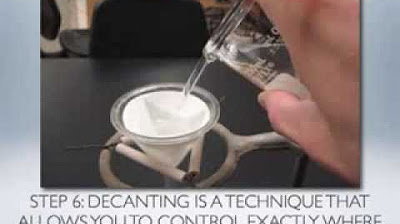Bunsen Burner and Glassware Safety (C) ACS 1991
Summary
TLDRThe video script emphasizes the safe use of a Bunsen burner, the primary heat source in chemistry labs, which produces a high-temperature open flame. It outlines the importance of not using it with volatile substances and the correct procedures for lighting, adjusting the flame, and heating glassware. Safety tips include checking for gas leaks, using tongs for hot objects, and never heating closed containers to prevent pressure build-up and potential explosions.
Takeaways
- 🔥 The Bunsen burner is the primary heat source in chemistry labs, producing a high-temperature open gas flame.
- ⚠️ There's a risk of accidents when using a Bunsen burner, especially with volatile organic liquids that release flammable vapors.
- 🌡️ For substances that are volatile, a heating mantle or steam bath in a hood is recommended instead of a Bunsen burner.
- 🔧 Bunsen burners have basic parts including a gas outlet, a rubber hose, a valve for gas flow, and air inlets for oxygen control.
- 🔄 A wing top can be used to spread the flame, and proper adjustment is needed for optimal burning.
- 🧰 Safety is paramount; check the gas hose for cracks and ensure the hose fits securely on both the gas valve and the burner.
- 🔥 Light the burner using a striker or match, being careful to follow safety protocols to prevent gas escape.
- 🔵 A properly adjusted flame should be blue with a lighter inner cone, with the tip of the inner cone being the hottest part.
- 🚨 If the flame sputters, flares, or goes out, or if unburned gas is smelled, turn the gas off immediately to prevent an explosion.
- 🧪 Be cautious with glassware; check for cracks or stars before heating, as they can break when heated.
- 🌡️ Flat-bottomed containers are normally heated on a wire screen, while narrow-necked containers should be clamped to secure them.
- 💧 Test tubes can be heated in a water bath for even heat distribution or directly in the flame, moved back and forth for even heating.
- 📦 Only heat containers with openings to allow gas to escape, as pressure buildup in closed containers can cause them to burst.
- 🧤 Use tongs or hot mitts to handle hot glassware and other heated equipment to prevent burns.
Q & A
What is the main heat source in most chemistry labs?
-The main heat source in most chemistry labs is the Bunsen burner, which produces an open gas flame at a high temperature.
Why should volatile organic liquids not be heated with a Bunsen burner?
-Volatile organic liquids should not be heated with a Bunsen burner because they give off flammable vapors, which can be dangerous. Instead, they should be heated in a heating mantle or a steam bath in a hood.
What are the basic parts of a Bunsen burner?
-The basic parts of a Bunsen burner include a gas outlet, a rubber hose, a valve at the bottom to control the flow of gas, air inlets to control the amount of oxygen in the flame, and a wing top that can be placed on the burner to spread the flame out.
What are some important safety rules to follow when using a Bunsen burner?
-Important safety rules include checking the gas hose for cracks, ensuring the hose fits securely, lighting the burner with a striker or match away from you, adjusting the flame for proper combustion, and turning off the gas immediately if the flame sputters, flares, or goes out.
How should you light a Bunsen burner properly?
-To light a Bunsen burner properly, open the gas line valve, strike the match away from you, and light the gas from the side to prevent the match from being blown out.
What should the color of a properly adjusted Bunsen burner flame be?
-A properly adjusted Bunsen burner flame should be blue with a lighter inner cone, with the tip of the inner cone being the hottest part of the flame.
What should you do if you smell gas while using a Bunsen burner?
-If you smell gas while using a Bunsen burner, you should immediately turn off the gas to prevent the unburned gas from igniting and causing an explosion.
Why is it important to check glassware for cracks or stars before heating?
-Checking glassware for cracks or stars is important because they can break open when heated, which can be dangerous and lead to accidents.
How should flat-bottomed containers be heated on a Bunsen burner?
-Flat-bottomed containers should be heated on a wire screen on a ring stand to distribute the heat evenly and prevent the container from breaking.
What is the recommended way to heat a test tube using a Bunsen burner?
-A test tube should be heated by holding it at an angle and moving it back and forth through the flame to distribute the heat evenly. It should be aimed away from yourself and others to prevent accidents if it boils over.
Why should you never heat closed containers on a Bunsen burner?
-You should never heat closed containers on a Bunsen burner because the boiling liquid changes to gas, which must escape. If it cannot escape due to the container being closed, the pressure that builds up can cause the container to burst.
What safety precautions should be taken when handling hot glassware or equipment?
-When handling hot glassware or equipment, use Beaker tongs or hot mitts to protect your hands, and always treat everything as if it's hot, even if it looks the same as when it's cold.
Outlines

此内容仅限付费用户访问。 请升级后访问。
立即升级Mindmap

此内容仅限付费用户访问。 请升级后访问。
立即升级Keywords

此内容仅限付费用户访问。 请升级后访问。
立即升级Highlights

此内容仅限付费用户访问。 请升级后访问。
立即升级Transcripts

此内容仅限付费用户访问。 请升级后访问。
立即升级5.0 / 5 (0 votes)






